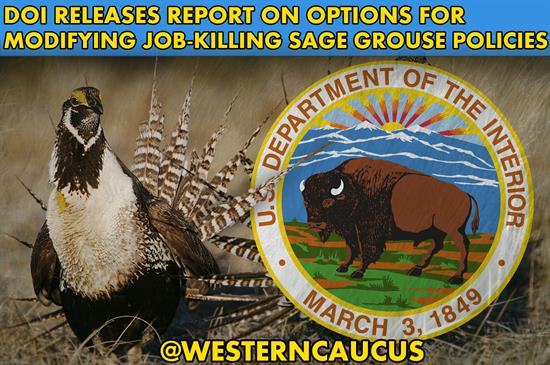Western Caucus Members Applaud DOI Sage Grouse Report
Washington, DC,
August 7, 2017
The de facto Sage-Grouse listing and proposed 10 million-acre mineral withdrawal from the Obama Administration is the greatest threat to the livelihoods of Western communities,” said Chairman Gosar. “Removing or modifying overly restrictive ‘sagebrush focal areas,’ increasing livestock grazing, removing ‘hard triggers,’ allowing for new mineral leasing and working with local stakeholders are all commonsense activities when discussing an issue that impacts 11 western states and 67 million acres of total land. Today’s report from the Sage-Grouse Review Team is a step in the right direction. I am hopeful that these recommendations will result in substantive actions that unwind the political and job-killing Sage-Grouse policies implemented by the Obama Administration that have wreaked havoc on the West.
Today, Congressional Western Caucus Chairman Paul A. Gosar D.D.S. (AZ-04) and Western Caucus member Doug LaMalfa (CA-01) released the following statements after the Department of the Interior (DOI) released a 52-page report from Sage-Grouse Review Team (DOI Team) regarding possible plan and policy modifications to complement state efforts in order to improve Greater Sage-Grouse conservation and economic development on public lands: “The de facto Sage-Grouse listing and proposed 10 million-acre mineral withdrawal from the Obama Administration is the greatest threat to the livelihoods of Western communities,” said Chairman Gosar. “Removing or modifying overly restrictive ‘sagebrush focal areas,’ increasing livestock grazing, removing ‘hard triggers,’ allowing for new mineral leasing and working with local stakeholders are all commonsense activities when discussing an issue that impacts 11 western states and 67 million acres of total land. Today’s report from the Sage-Grouse Review Team is a step in the right direction. I am hopeful that these recommendations will result in substantive actions that unwind the political and job-killing Sage-Grouse policies implemented by the Obama Administration that have wreaked havoc on the West.” “The restrictions on Sage Grouse habitat under the Obama Administration were both unwarranted and ineffective. The Sage Grouse is neither endangered nor threatened and, in fact, the species is now considered to be quite abundant. In reality, this was an attack on American energy production in the west. I am glad Secretary Zinke and the Department of Interior have taken the time to make the right decision and take a more responsible approach to conservation,” Congressman LaMalfa concluded. In signing Secretarial Order 3353, Secretary Zinke established an internal review team to evaluate both Federal Sage Grouse plans and state plans and programs to ensure they are complementary. Together, the DOI Team, and managers and staff from the Bureau of Land Management (BLM), U.S. Fish and Wildlife Service (FWS), and U.S. Geological Survey (USGS), and the Sage-Grouse Task Force (SGTF)—made up of representatives of the Governors of each of the Eleven States—identified issues, options to address those issues, and next steps to implement the Order. This report recommends continued collaboration with the States, including both through the SGTF and between each Governor’s office and the respective Bureau of Land Management (BLM) State Director and USFS Regional Forester, as well as key BLM and USFS national-level Directors. This report also recommends engagement on the issues and options identified in this report with Congressional delegations, counties, local governments, and tribes, as well as with ranchers, industry, conservation groups, and other stakeholders. This additional engagement would be used to refine the options and develop a plan for prioritized implementation of the options in this report. The review conducted in response to the Order identified many opportunities, summarized in this report, to clarify the BLM’s management under the 2015 GRSG Plans. Clarifications, policies, agreements, or training could: (1) address issues related to habitat assessment and monitoring, including the Habitat Assessment Framework, and grazing management; (2) take advantage of flexibility in the 2015 GRSG Plans to support energy, mineral, and other development; (3) increase consistency between the BLM and States on density and disturbance caps and mitigation; and (4) in some cases, allow adjustments to habitat boundaries and address issues with adaptive management. The review also identified longer term options to consider some issues through a potential plan amendment process. This report recommends further investigation of potential plan amendments, including considering what combination of potential plan amendments would best balance continuing to conserve the GRSG and its habitat and supporting economic development, and whether to consider State-by-State or range-wide amendments. Potential plan amendments could be considered in some States to remove or modify sagebrush focal area (SFA) designations; address adjustments to habitat management boundaries; adjust responses to reaching adaptive management triggers; evaluate the compensatory mitigation standard; and provide additional flexibility in resource development. The report identifies opportunities to improve coordination on fire, fuels, and invasive species management develop MOUs, increase data sharing, initiate new research, and incorporate new information into plan implementation. The report also includes recommendations on captive breeding, translocations, predator control, and setting population targets. Courtesy of the Congressional Western Caucus: ### |
||||
Stay Connected
Use the following link to sign up for our newsletter and get the latest news and updates directly to your inbox.


